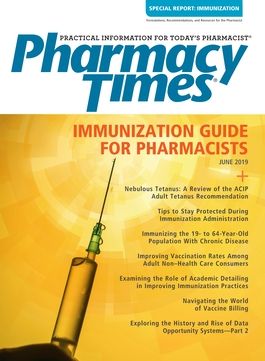Publication
Article
Supplements
Tips to Stay Protected During Immunization Administration
Author(s):
Pharmacists can put many safeguards into place to ensure patient safety when providing immunizations.
Pharmacists can put many safeguards into place to ensure patient safety when providing immunizations. Although patient safety is always crucial, pharmacists may not be doing enough to ensure their own safety during the immu- nization process. As immunizers, pharmacists can protect themselves in a number of ways. This article focuses on proper administration technique and safety-focused equipment that can keep both patient and immunizer safe.
FOCUS ON TECHNIQUE
Proper immunization technique is the most important aspect in protecting immunizers against both accidental finger sticks and exposure to bloodborne pathogens. Before preparing immunizations, pharmacists should clean their hands with soap and water or an alcohol-based hand sanitizer. During preparation, work in a clutter-free location that is as free from distraction as possible, and always maintain a keen focus on an uncapped needle, especially when recapping is necessary. To recap, scoop up the cap with the needle and secure it by applying pressure against a firm, clean, nonslip surface. Always use only 1 hand when scooping up the cap.
When administering an immunization, focus on these key steps:
- Wear properly fitting gloves to protect against potential exposure to bloodborne pathogens. Gloves that are too large can get caught on the syringe, whereas those that are too tight can break during administration.
- Never take eyes off an uncapped needle until the injection has been performed and the nee- dle has been safely discarded in a sharps con- tainer. The container should be on the same side as the hand that is holding the syringe. This will prevent the needle from passing over any part of the immunizer’s body on the way to the sharps container.
- Put the needle into the sharps container immediately after withdrawing it from the patient. Any attempt to clean up blood or apply a bandage should come only after the needle has been properly discarded.
The immunizer should keep an adequate supply of sterile gauze and bandages nearby to minimize bleeding from the patient and reduce the risk of bloodborne pathogen exposure. Hold any material contaminated with blood in the palm of 1 gloved hand, and contain the material on the inside of the glove while removing it and turning it inside out with the opposite hand. This will form a pouch and contain the contaminated material, which can then be safely discarded. After the immunization, pharmacists should again wash their hands or use sanitizer to help eliminate any contaminants they might have touched.
USE PROTECTIVE EQUIPMENT
Another important component of immunization administration is the use of safety-focused equipment or devices, in addition to properly fitting gloves. Use prefilled syringes whenever possible to reduce accidental finger sticks during preparation; this way, immunizers only need to attach the needle to the syringe. Prefilled syringes also cause less pain for the patient because the needle has not been previously inserted through a stopper in a vial, which could slightly dull the needle’s tip.
Pharmacists should use a safety syringe for all immunizations to also reduce the risk of finger sticks after the immunization. One type contains a spring-loaded retractable needle and a button on the end of the plunger or at the base of the needle. Press or squeeze the button to retract the needle into the barrel of the syringe, leaving no exposed tip to remove from the patient upon completion of the injection. Remember to activate the needle while it is still in the patient. The activation has an audible click that the immunizer should alert the patient to, but it does not cause any additional pain. If the device does not activate properly, withdraw the needle from the patient and place it directly into the sharps container. There is no need to activate the device after withdrawing it from the patient.
A second type of safety syringe features a sheath that the immunizer can slide over the needle tip after removing it from the patient. Using the thumb of the administration hand, simply push the sheath forward until it covers the needle. Immunizers should point the needle down and away from them before activation to prevent any residue from spraying onto them or the patient when the sheath is put into place. Do not involve the nonimmunizing hand in this process.
A newer piece of protective equipment is a barrier bandage that pharmacists can place on the patient before the immunization. This bandage has a membrane in its center that will allow the needle to be inserted through it and into the patient. The membrane will seal itself after the needle is removed and contain any blood if the patient bleeds. The immunizer should instruct patients to apply light pressure to the outside of the bandage if they are bleeding. With this safety bandage, the immunizer is never exposed to the patient’s blood.
CONCLUSION
Pharmacist safety is sometimes an afterthought when planning immunization best practices; however, during any immunization administration, both patient and pharmacist are at risk. By following proper techniques and using safety equipment, a diligent pharmacist can minimize the risks and help guarantee a successful immunization program.
BRADY COLE, RPH, is pharmacy manager at Tom Thumb Pharmacy in Plano, Texas, and an active preceptor at Texas Tech University and the University of Houston. He is also the founder of the website Helpful Pharmacist (helpfulpharmacist.com).







